Mandala art therapy combines ancient circular designs with modern relaxation techniques. These colorful, symmetrical patterns help reduce anxiety and stress while promoting mindfulness. Anyone can create mandalas using simple tools like paper, markers, and a compass. The repetitive process of drawing from the center outward naturally calms the mind, much like meditation. Many therapists recommend mandala creation for emotional expression and healing. Beyond beautiful artwork, these sacred circles offer a pathway to inner peace and self-discovery.
Key Takeaways
- Mandala art creates a meditative state through repetitive patterns and structured circles, reducing anxiety more effectively than random doodling.
- Basic supplies include paper, permanent markers, and a compass, while a quiet, distraction-free space enhances the therapeutic experience.
- Start with a central circle and build outward using simple shapes like triangles and petals, embracing imperfections in your design.
- Use color theory intentionally—warm colors energize while cool tones calm—to express emotions and enhance the therapeutic benefits.
- Incorporate personal symbols and gratitude elements to transform your mandala into a visual representation of your inner thoughts and feelings.
The Ancient Origins of Mandala Art
Circles, one of the most perfect shapes in nature, form the foundation of mandala art, an ancient practice that spans thousands of years across multiple civilizations. These cosmic diagrams originated from Sanskrit, where “mandala” literally means “circle,” and they’ve played vital roles in Eastern traditions like Hinduism and Buddhism.
Throughout history, people created these intricate circular designs to represent the universe and our place within it. Monks would spend days crafting detailed mandalas from colored sand, teaching patience and impermanence.
In the sacred geometry of mandalas, monks paint universes with colored sand—ephemeral portraits of cosmic order and human transience.
When Carl Jung discovered their power, he brought mandalas into Western Art Therapy practices, recognizing how creating these patterns could help people express emotions they couldn’t put into words.
The journey toward spiritual enlightenment these designs represent isn’t just ancient history—it’s a living tradition that continues to help people find peace in our chaotic world.
Understanding the Therapeutic Benefits of Mandalas
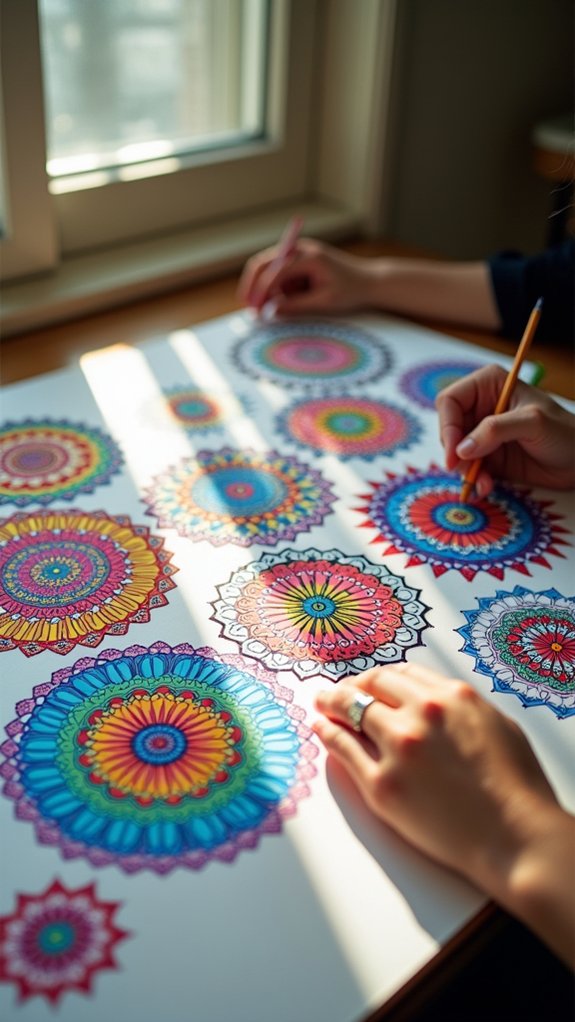
While ancient practitioners may have used mandalas primarily for spiritual purposes, modern research has revealed their remarkable healing power for our minds and emotions.
Studies by researchers like Nancy Curry and Tim Kasser show that mandalas actually reduce anxiety better than just doodling whatever comes to mind!
Mental health professionals, including many an art therapist, now regularly use mandala creation to help patients dealing with anxiety, PTSD, and other emotional challenges.
The structured patterns create a safe space for expressing feelings that might be too difficult to put into words.
No wonder adult coloring books featuring mandalas have become so popular!
When someone focuses on coloring these intricate designs, they enter a mindful state that calms the nervous system and provides a much-needed break from life’s chaos.
Essential Supplies for Your Mandala Practice
Creating your own mandalas requires just a few essential supplies, though options range from basic to premium materials.
Every mandala artist should start with a simple kit including paper, permanent markers, and perhaps a compass, while those seeking more elaborate results might invest in specialized pens, high-quality colored pencils, or watercolors.
For those watching their budget, everyday items like index cards, school markers, and even coffee filters can serve as perfectly acceptable alternatives to expensive art supplies.
Basic Starter Kit
Starting on your mandala art journey requires just a few simple tools to get started. The basic starter kit for creating beautiful mandalas doesn’t need to be fancy or expensive! High-quality paper, like watercolor paper, gives you a smooth surface that won’t tear or buckle when you really get into your drawing flow.
- Blank page – Your canvas for endless possibilities!
- Permanent markers – Both regular and chisel tip for varying line thickness
- Compass and ruler – For those perfectly satisfying circles and symmetrical patterns
- Optional color tools – Paints or colored markers to bring your creation to life!
These simple supplies will have you creating gorgeous, relaxing mandalas in no time, while enjoying all the mindfulness benefits that come with this ancient practice.
Premium Art Materials
For those ready to take their mandala art to the next level, premium art materials can transform the entire creative experience.
Artists seeking finer details and more vibrant coloring might invest in Arches Watercolor Paper Blocks, which provide the perfect smooth surface for complex mandala patterns.
The Mungyo Professional Water Colors Set, with its impressive 24-color palette, allows for richer expression and stunning color gradients within mandalas.
For precision work, Squirrel Hair Professional Brushes deliver fluid strokes that make detailed coloring a joy rather than a challenge.
Don’t forget a quality Micron Ink Pen Set for crisp outlines!
While these supplies cost more than basic materials, many artists find the difference astonishing.
Better tools create beautiful results and, surprisingly, make the whole process more relaxing and fun!
Budget-Friendly Alternatives
Many artists create stunning mandalas without spending a fortune on supplies. Art therapy through mandala coloring doesn’t require expensive materials to be effective or beautiful. With just a blank page and some basic permanent markers, anyone can begin their mindfulness journey through circular designs.
Affordable options that work wonderfully include:
- Basic permanent markers for outlining (chisel tips work great for varying line thickness!)
- Simple watercolor sets instead of pricey professional paints
- Repurposed everyday items like pencils and erasers you already own
- Free downloadable mandala coloring sheets from the internet
These budget-friendly alternatives make mandala art accessible to everyone, regardless of financial constraints.
The focus should be on the meditative process, not breaking the bank on fancy supplies!
Setting Up Your Creative Space
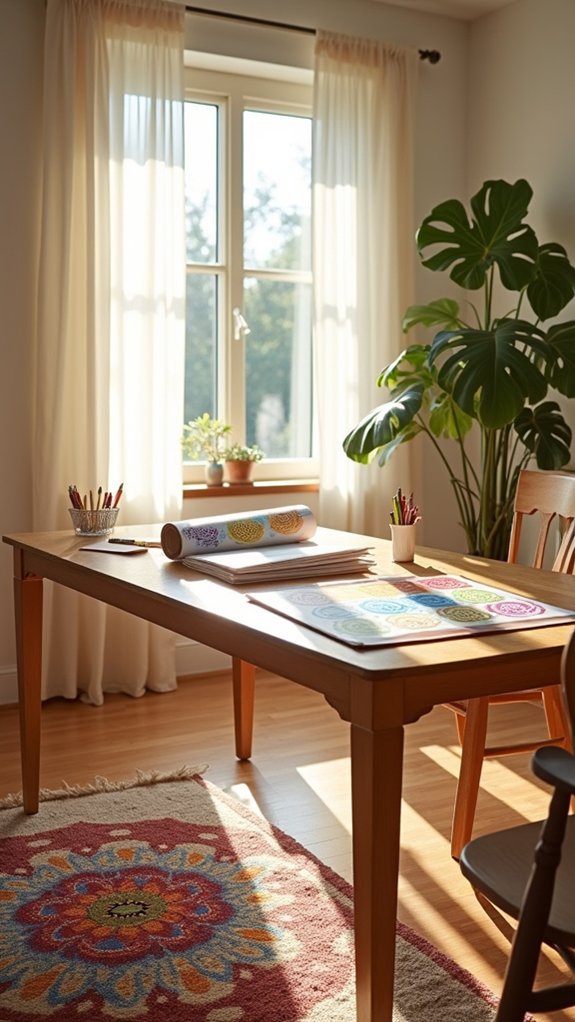
The foundation of effective mandala art therapy lies in creating a sanctuary for your creative spirit. Many artists who often use mandalas recommend finding a quiet, distraction-free corner in your home where creativity can flow freely.
Creating a quiet sanctuary space is the first step toward unlocking mandala therapy’s transformative power.
While some specialty stores (where we receive a small commission through affiliate links) offer fancy setups, a simple table near natural light works perfectly!
Arrange your supplies—markers, blank pages, and paints—within arm’s reach to maintain your creative momentum. Soft lighting creates a peaceful mood that helps your mind settle into the meditative process.
Add personal touches like plants or meaningful trinkets to make the space truly yours.
Remember to set a regular time for your mandala practice, turning it into a cherished ritual rather than a random activity.
Basic Techniques for Drawing Perfect Circles
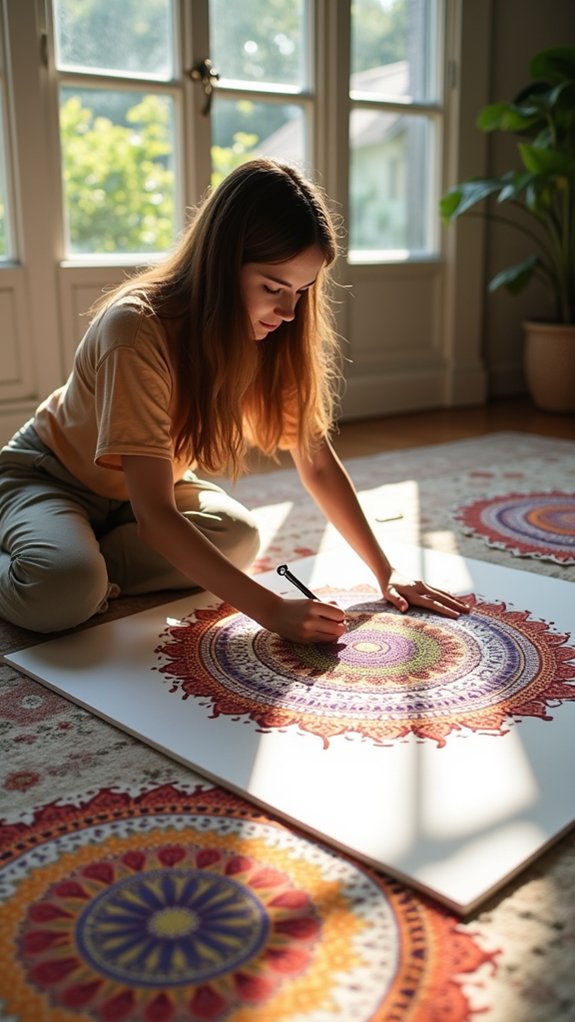
Creating mandalas begins with mastering the art of perfect circles, which form the foundation of these mesmerizing designs.
Students can explore various tools like compasses, circular templates, or even household objects to achieve consistently round shapes that radiate from a clearly marked center point.
Once the basic circles are established, artists can experiment with division techniques—marking the circles into equal sections like slicing a pie—which creates the framework for the intricate patterns that make each mandala unique.
Finding Your Center Point
Discovering your center point forms the foundation of every beautiful mandala creation. This vital first step in circle symmetry techniques guarantees that your mandala will have perfect balance, which is essential for visual meditation practices.
Think of your center point as the heart of your artwork!
To create a strong center point:
- Place a small, precise dot in the middle of your paper using a sharp pencil.
- Secure your compass needle directly on this dot (it should barely make a hole!).
- Test your compass setting on scrap paper first to avoid mistakes.
- For freehand circles, imagine this center point pulling your hand around in an even orbit.
Many mandala design inspirations begin with this simple dot, from which intricate patterns will eventually bloom outward, like ripples in a pond.
Tools for Perfect Circles
Mastering the art of drawing perfect circles transforms ordinary mandalas into breathtaking masterpieces of symmetry and balance. Artists use various circle drawing techniques that range from simple to sophisticated, depending on their skill level and available tools. A compass remains the most reliable method, offering precision that freehand attempts can’t match.
| Tool | Best For | Skill Level |
|---|---|---|
| Compass | Precise circles | Beginner-Advanced |
| Household objects | Tracing circle methods | Complete beginners |
| Freehand | Organic designs | Intermediate |
For beginners struggling with compass usage tips, remember to hold the metal point firmly in place while rotating the pencil end smoothly. Don’t worry if perfection doesn’t happen right away! Even experienced artists sometimes trace cups or lids when they need consistent circles. With practice and the right tools, anyone can create stunning circular frameworks for their mandala art.
Circle Division Techniques
The heart of mandala creation lies in circle division techniques that transform a plain circle into a foundation for intricate designs. Understanding radial balance principles helps artists create symmetrical patterns that flow outward from the center, giving mandalas their mesmerizing quality.
- Use a protractor to mark equal angles from the center point — like slicing a pizza into perfectly even pieces!
- Draw straight lines from center to edge, creating pie-shaped sections for your geometric pattern exploration.
- Place evenly-spaced dots around the circumference using compass measurements.
- Connect these points with arcs or straight lines to form the framework for detailed designs.
These circle symmetry techniques might seem tricky at first, but don’t worry! With practice, you’ll soon be dividing circles like a pro, ready to fill them with amazing patterns.
Creating Your First Simple Mandala
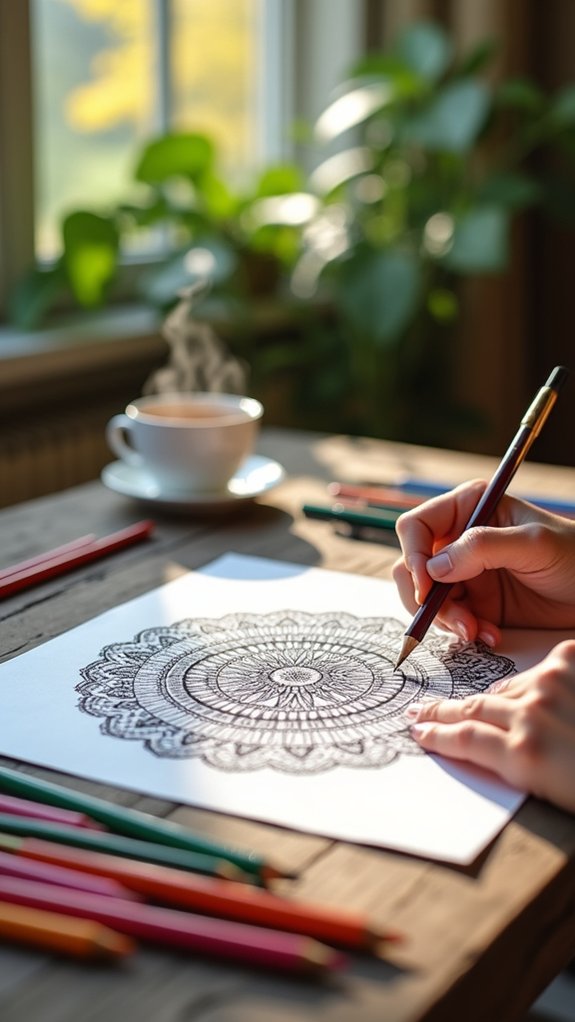
When beginning your first simple mandala, a small circle in the center of your blank page sets the foundation for your artistic journey. From this humble start, you’ll build outward using simple shapes like triangles, circles, and pretty petals that form rings of design variations. Don’t worry about getting everything perfect—that’s the beauty of mandalas!
| Level | Simple Shapes | Detail Ideas | Personal Symbolism |
|---|---|---|---|
| Core | Circle | Dots | Your center |
| Inner | Petals | Zigzags | Emotions |
| Middle | Triangles | Waves | Memories |
| Outer | Stars | Stripes | Connections |
After creating your basic pattern, fill empty spaces with fun details. Got wobbly lines? No problem! Grab a chisel tip marker to thicken uneven areas, turning “mistakes” into unique features of your personal creation.
Adding Complexity With Patterns and Symbols
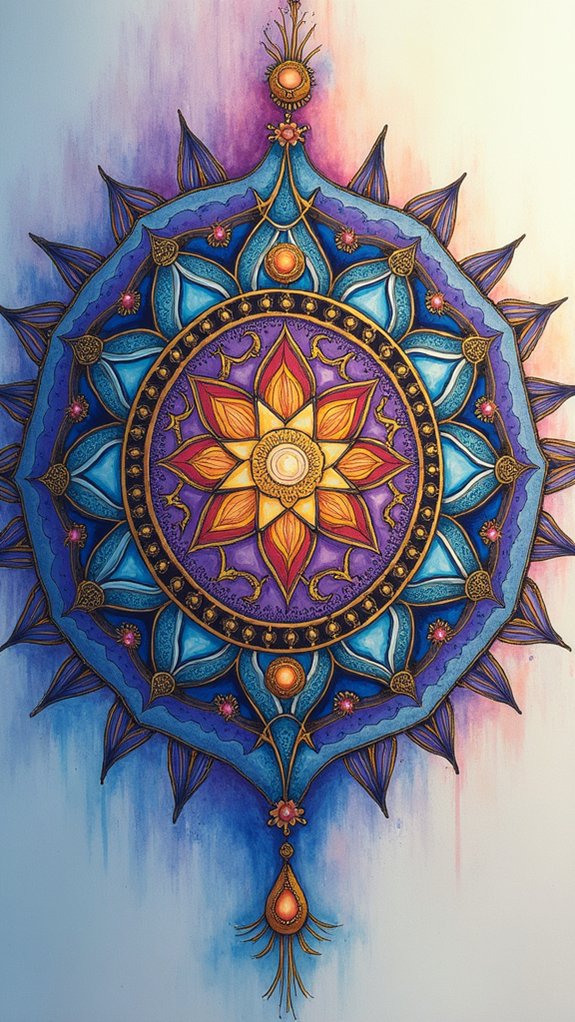
Once you’ve gained comfort with basic shapes, your mandala journey can truly blossom with intricate patterns and meaningful symbols.
Pattern exploration becomes exciting when artists mix spirals, zigzags, and floral designs to create visual depth that practically jumps off the page!
Dynamic composition emerges through:
- Varying shapes and sizes throughout your mandala
- Adding texture with dots and delicate line work
- Incorporating personal symbols that speak to your heart
- Embracing happy accidents as part of your unique expression
Symbol significance shouldn’t be overlooked—hearts, stars, or other meaningful images can transform your mandala from pretty artwork into a visual story of your inner world.
Color Theory for Emotional Expression in Mandalas
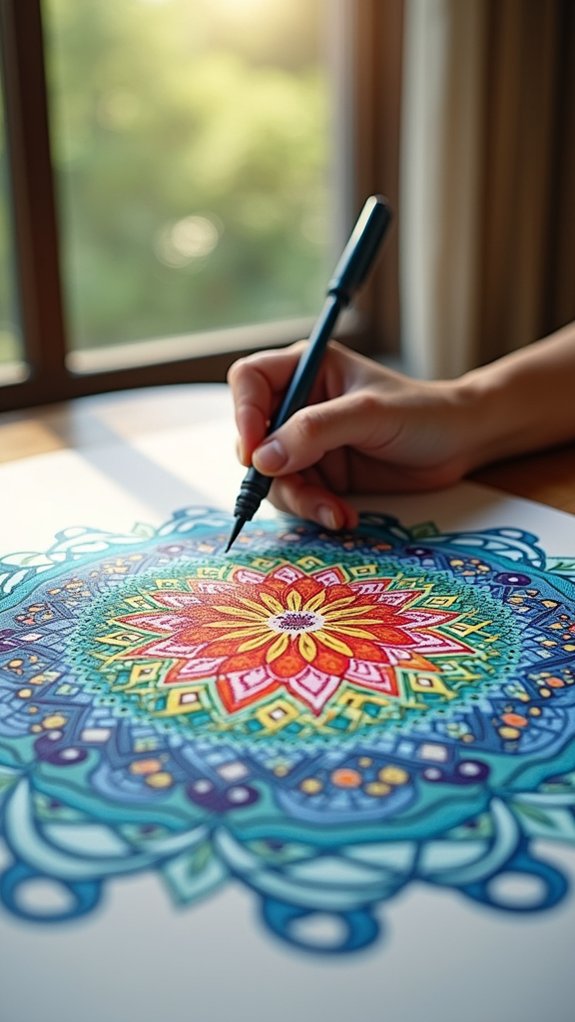
When choosing colors for mandala art therapy, understanding what each shade can make you feel is super important.
Blue might help you feel peaceful when you’re stressed out, while fiery reds and oranges can boost your energy when you feel down.
Picking the right colors for your current emotional state isn’t just about making something pretty—it’s like giving yourself a custom-designed emotional boost that speaks directly to what you need right now.
Color Meanings Matter
The power of color transforms a simple mandala into a window to the soul. Through color symbolism exploration, artists tap into subconscious emotional territories while creating meaningful designs. Choosing specific hues isn’t just aesthetic—it’s therapeutic communication.
When working with emotional color palettes, remember:
- Warm colors (reds, oranges, yellows) energize and evoke passion.
- Cool tones (blues, greens, purples) calm the mind and encourage reflection.
- Contrasting colors can represent emotional conflicts needing resolution.
- Neutral shades provide balance when emotions feel overwhelming.
Color choice strategies matter because our brains react differently to various hues. Feeling anxious? Try working with blues and greens.
Need motivation? Splash some yellow or orange in your mandala. The colors you choose speak volumes about your inner environment—sometimes revealing truths you didn’t even know were there!
Selecting Therapeutic Tones
Understanding how colors affect our emotions allows artists to harness their therapeutic power in mandala creation.
Through color symbolism exploration, artists can select tones that match their emotional needs – warm reds and oranges to boost energy, or cool blues and purples to calm anxious thoughts.
When approaching emotional palette selection, consider your current feelings. Are you seeking excitement or tranquility?
Many artists keep a journal of personal color reflections, noting how different hues impact their mood during mandala practice.
Some days, a fiery red center might feel perfect, while other times, a soothing green border brings needed balance.
Mindfulness Meditation While Drawing Mandalas
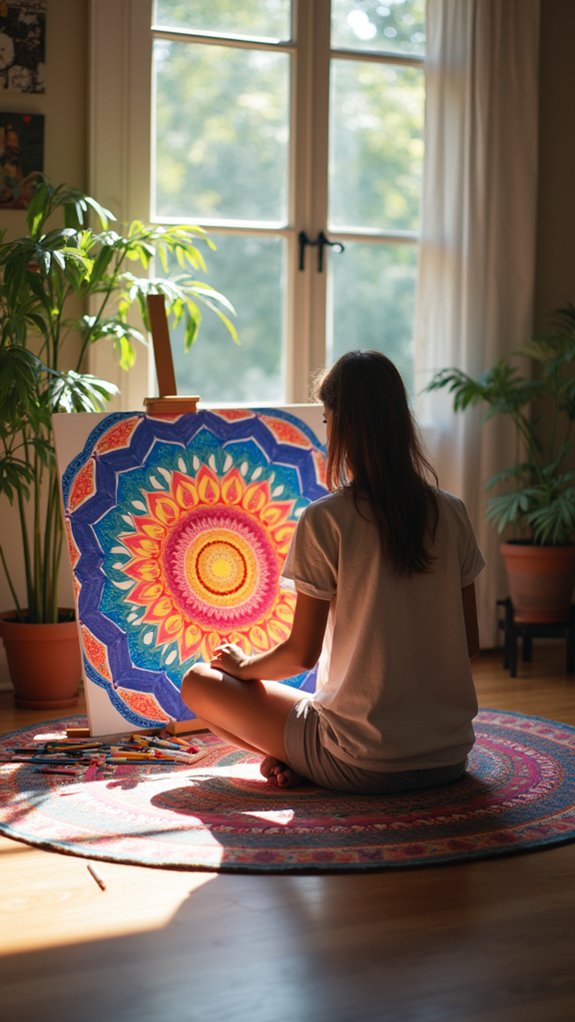
Mindfulness emerges powerfully when drawing mandalas, creating a unique bridge between artistic expression and meditation practice. Research shows that this focused activity reduces anxiety better than free-form drawing, offering a peaceful escape from everyday stress.
The mandala techniques invite creative exploration while calming the mind, making this practice valuable for everyone from beginners to experienced artists.
The mindfulness benefits of mandala drawing include:
- Enhanced present-moment awareness that blocks out distractions
- Deep relaxation that can help people dealing with trauma or PTSD
- A playful way to explore creativity without judgment
- A form of active meditation that improves mental well-being
This combining of art and mindfulness doesn’t just feel good—it transforms how we process emotions, turning simple circles into powerful tools for healing and self-discovery.
Using Mandalas for Stress Reduction
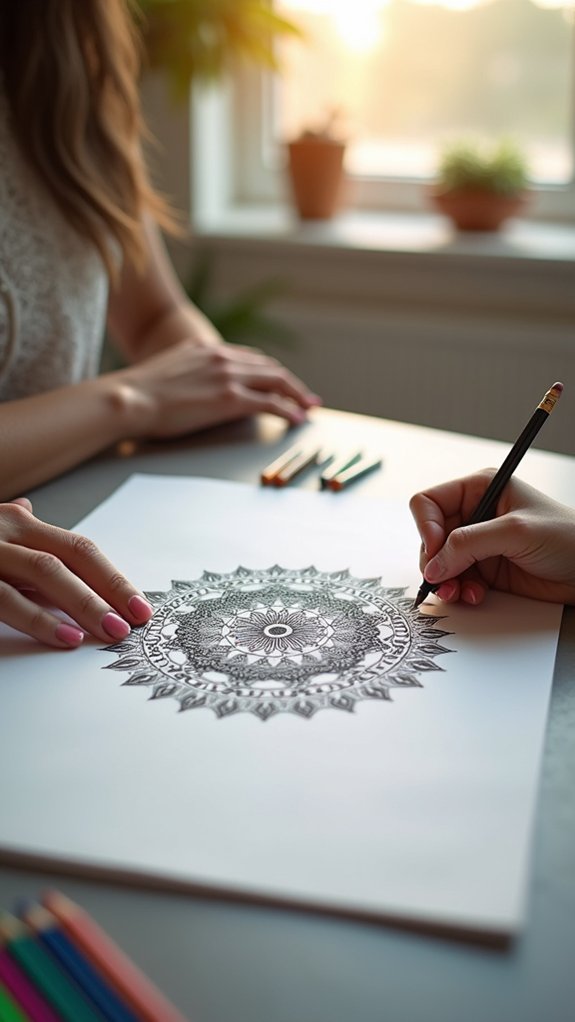
Many people have discovered a powerful antidote to modern life’s constant pressure in the simple practice of mandala creation. When anxiety feels overwhelming, picking up colored pencils and focusing on the circular patterns offers genuine relief. Studies by researchers Curry and Kasser confirm that mandalas reduce stress more effectively than random doodling, making them awesome tools for emotional healing.
| Mandala Benefits | For Kids | For Adults |
|---|---|---|
| Stress Relief | Calms hyperactivity | Reduces work anxiety |
| Creative Expression | Builds confidence | Releases emotions |
| Mindfulness | Improves focus | Deepens meditation |
The circular designs invite both meditation and creative expression, helping people process complicated feelings without words. PTSD patients have found significant comfort in this practice, proving that sometimes the most powerful healing happens through the simplest artistic activities.
Incorporating Gratitude Practice Into Mandala Creation
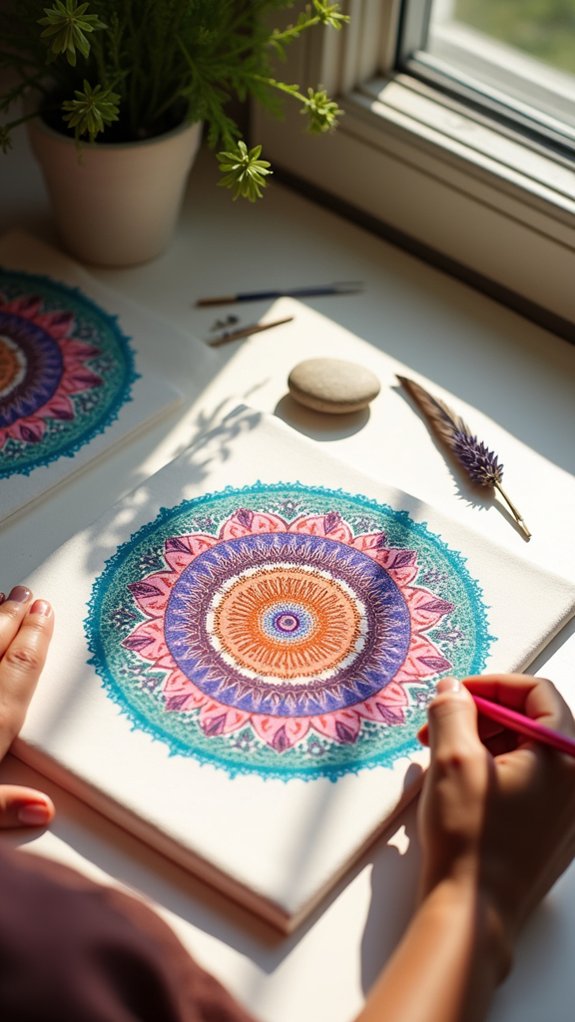
Transforming the traditional mandala into a visual celebration of gratitude opens up powerful new dimensions for healing and joy.
In mandala workshops across the country, participants weave personal reflections into circular designs, creating meaningful art that shifts energy from negative to positive.
To create your own gratitude mandala, try these approaches:
- Place specific gratitude symbols at key points in your design, representing important blessings.
- Use different colors to express the unique feeling behind each thing you’re thankful for.
- Write tiny words of thanks within patterns to add layers of meaning.
- Draw simple shapes that remind you of people or experiences that bring you joy.
This creative process doesn’t just result in beautiful art—it builds community and fosters emotional healing while making gratitude visible!
Seasonal and Nature-Inspired Mandala Designs
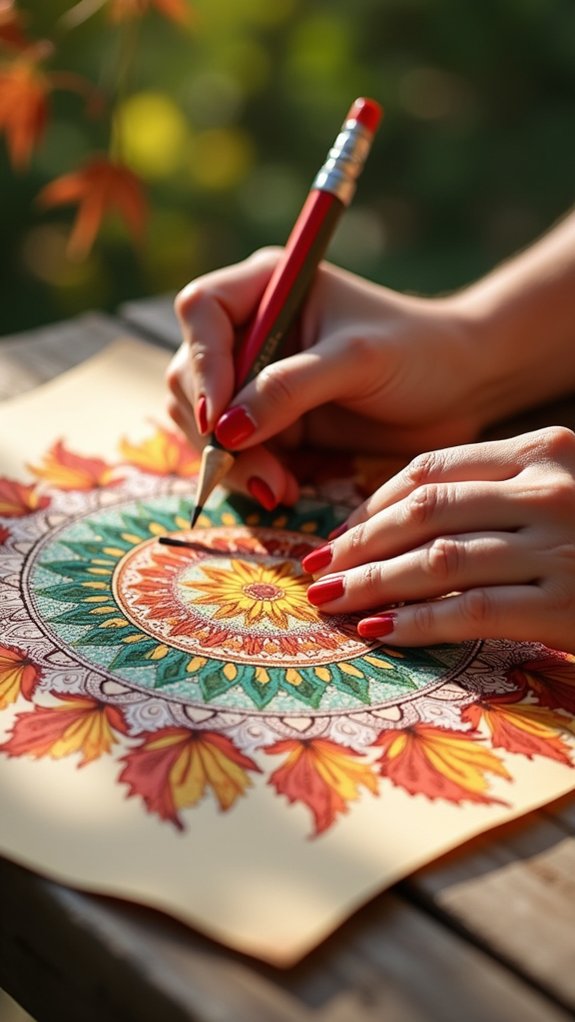
The four seasons offer a rich palette of inspiration for creating stunning mandala designs that reflect the ever-changing world around us. Artists find seasonal inspiration in autumn’s golden leaves, winter’s crystalline snowflakes, spring’s unfurling petals, and summer’s vibrant blooms—each element becoming a meaningful piece of their circular creations.
Nature appreciation deepens the meditative experience when practitioners incorporate actual elements from their environment—placing stones, pressing flowers, or imprinting leaves directly into their artwork. This tangible connection to the natural world often sparks profound emotional reflection, helping individuals process feelings about time’s passage.
Many find that creating season-based mandalas helps them navigate through life’s changes with grace. It’s like telling nature’s story through art—and, hilariously enough, even that pesky ragweed can look beautiful in the right mandala!
Digital Tools for Modern Mandala Artists
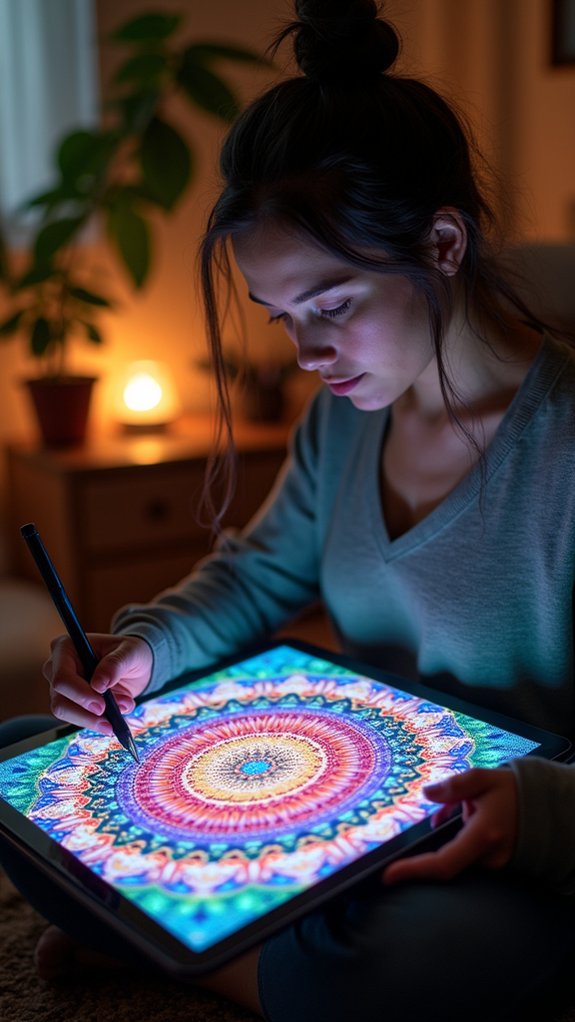
Modern mandala artists are discovering the incredible power of digital tools, like tablet drawing apps that offer unique brushes and perfect symmetry tools.
Creating vector mandalas allows artists to scale their designs without losing quality, making them perfect for both social media sharing and large-format printing.
These digital methods don’t replace traditional techniques, but instead open up exciting new possibilities for artists who want to explore mandala creation with a technological twist.
Tablet Drawing Apps
Digital tools have revolutionized mandala creation for artists seeking precision and flexibility in their spiritual practice. Tablet drawing apps like Procreate and Adobe Fresco offer incredible digital art advantages, enabling creative expression through countless brushes and tools.
The mobile drawing experience means artists can practice their mindfulness art anywhere, anytime!
These apps make mandala creation super fun and easy with:
- Layering features that let you build complex designs without messing up your whole artwork
- Amazing symmetry tools that automatically balance your patterns (no more wobbly lines!)
- Pre-made templates for beginners who aren’t sure where to start
- Undo buttons that take away the stress of making mistakes
The portability of tablet apps transforms mandala drawing into a convenient relaxation practice that fits perfectly into busy modern lives.
Creating Vector Mandalas
Vector mandalas represent a significant advancement in digital art creation, allowing artists to craft perfectly symmetrical designs with remarkable precision and flexibility. Unlike traditional methods, vector design techniques enable creators to zoom, rotate, and modify their patterns without losing quality, making digital mandala software an incredibly powerful tool.
When artists explore digital mandala creation, they discover endless possibilities for self-expression and therapeutic release through art that can be infinitely adjusted and shared.
| Software Features | Beginner Tools | Advanced Techniques |
|---|---|---|
| Shape BuilderS | Basic circles | Color gradients |
| Symmetry tools | Simple patterns | Complex layering |
| Pen tool options | Star shapes | Scaling mandala artwork |
The ability to scale vector mandalas without pixelation means artists can print their calming creations as tiny cards or massive wall art, expanding how these meditative designs can be shared and experienced.
Sharing Your Mandala Journey With Others
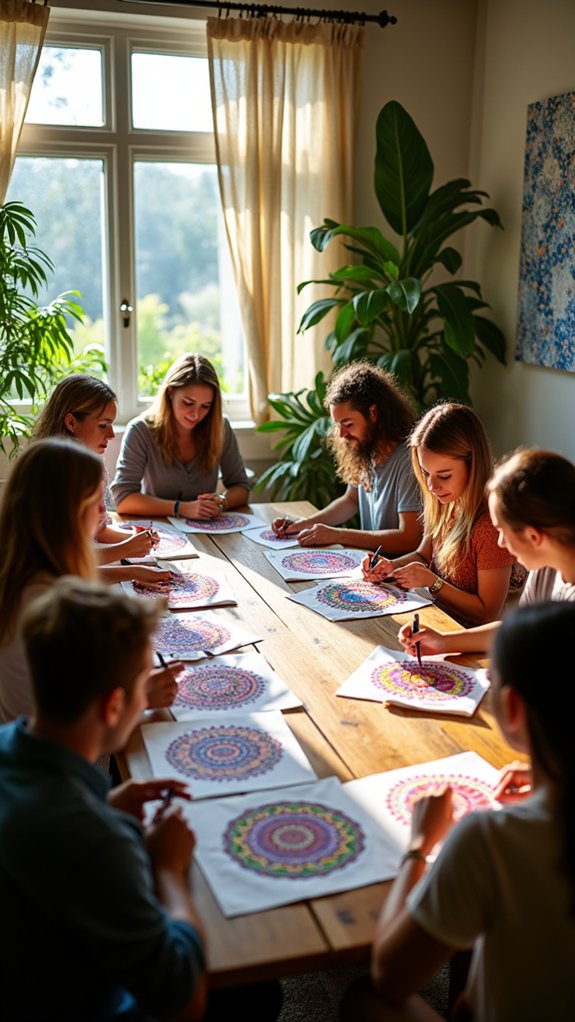
While creating mandalas offers profound personal benefits, sharing this artistic journey with others can multiply its positive effects in unexpected ways.
Through community engagement, artists find their practice enriched by diverse perspectives and techniques. The emotional connection formed when discussing the symbolism in your designs can lead to surprising insights and deeper self-awareness.
When we share our mandalas with others, we discover new dimensions in our art and ourselves.
Art sharing opportunities include:
- Joining mandala-making groups where techniques and stories flow freely
- Posting progress photos online to inspire and connect with fellow artists
- Exhibiting works in local community spaces to spark conversations
- Participating in art therapy sessions where mandalas become a shared language
Many find that their most meaningful mandala moments happen when someone else connects with their creation, turning a personal meditation into a bridge between hearts and minds.
Frequently Asked Questions
How Do Mandalas Help With Mindfulness?
Mandalas cultivate mindfulness through visual meditation, requiring focused attention on geometric patterns. This mindful creation process anchors practitioners to the present moment, quieting mental chatter and fostering deep consciousness.
What Did Carl Jung Say About Mandalas?
Jung considered mandalas powerful tools in Jungian psychology, representing the unified self through personal symbolism. He viewed them as vehicles for creative expression that reveal unconscious material and facilitate psychological integration.
How Is Mandala Art Used in Therapy?
Mandala art in therapy offers therapeutic benefits through guided creative expression, promoting emotional healing and stress reduction while enhancing mindfulness. Therapists use mandalas as tools for processing trauma and cultivating self-awareness.
How Does Mandala Relieve Stress?
Mandala relieves stress through color therapy’s soothing properties, creative expression that channels emotions, and visual meditation that focuses attention, allowing the mind to enter a calming state of mindful presence.
Conclusion
Mandala art therapy offers a wonderful journey of self-discovery and relaxation that anyone can enjoy. Through colorful circles and patterns, people find peace in our hectic world. Whether you use traditional art supplies or digital tools, the ancient practice continues to bring joy and healing to modern lives. So grab your pencils, find a quiet space, and let your creativity bloom—one beautiful mandala at a time!

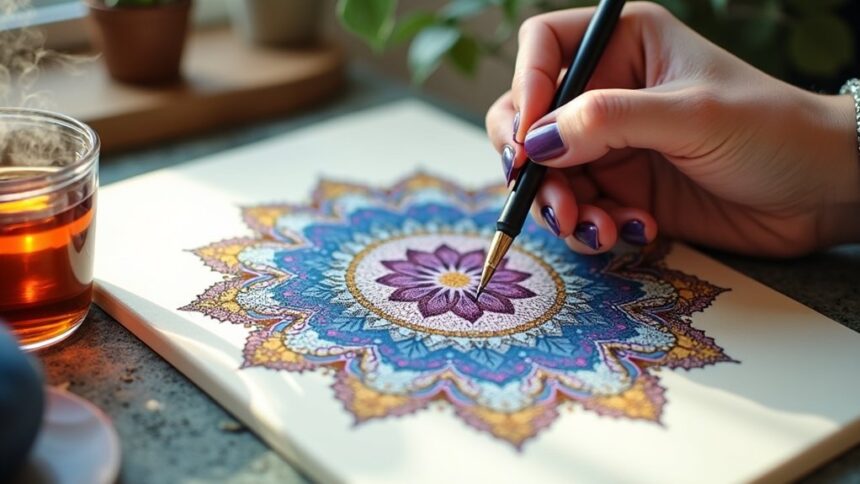
Leave a Reply